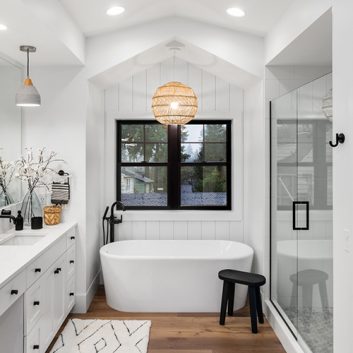Your Guide to Tempered Glass
By: Architectural Visions
Glass is a consistent component of any household structure. It’s a crucial makeup of our windows, doors, and sometimes even walls and ceilings. Therefore, the type of glass used is often a key factor to consider in many home renovations. When considering a door or window renovation, you’ll definitely need to account for the fact that you may be required (and certainly want) to use what is known as tempered glass.
Here at AVI Windows and Doors, we have the know-how and expertise to help you understand what tempered glass is and where and how to best install tempered glass in your home. Here is a brief guide to what tempered glass is, what is does, why you need it in your home, and where you should consider installing it in your next home renovation.
Key Takeaways:
- Tempered glass is created after the glass is heated rapidly, followed by immediate cooling
- Tempered glass is nearly five times stronger than standard glass, making it less likely to shatter
- Because tempered glass is more durable than standard glass, it is considered to be safer and is often placed in high traffic areas
- According to International Residential Code, tempered glass must be used for swinging, sliding, operable, fixed, or bifold doors
What is Tempered Glass?
First, let’s understand what tempered glass is and why you need it in your home. Face it: glass is a material prone to breaking. Tempered glass, however, is a glass that is treated to be roughly five times stronger than standard glass. It is not unbreakable of course, but when tempered glass is shattered, it turns into small square pieces that are less like to pose a safety hazard. Logically speaking, if glass is going to break, there are places in the home where it is much safer to have this type of shattering occur, such as a highly trafficked doorway or in the bathroom.
How is Tempered Glass Made?
Tempered glass is created by rapid heating of the glass followed by immediate cooling, thus giving the glass a stronger composition and changing the way it breaks.
Where does Tempered glass go in the household?
Where tempered glass goes in your household will certainly be determined by where you are considering safety a high priority, and there are already even international standards of where tempered glass must go. In fact, some states have even stricter regulations.
Benefits of Tempered Glass
As mentioned above, tempered glass is significantly more durable than other types of glass such as annealed, or standard glass. Therefore, it is also a much sounder investment, as while more expensive than annealed glass, tempered glass durability makes it pay off in the long run. Furthermore, when glass such as annealed breaks, it creates jagged and sharp shards that shatter everywhere. So, when safety is a top priority, such as in a highly trafficked area or a place where slipping and falling is more probable, you need to consider tempered glass.
Tempered Glass in Doors
According to what is known as the International Residential Code, all glass and panels must be tempered in these types of doors: swinging, sliding, operable, fixed, and bifold. This is true regardless of panel size. Furthermore, you must temper any glass within 24 inches of a door with its bottom edge less than five feet above said door. As mentioned before, some states in the US have stricter codes.
Tempered Glass in Windows
Likewise, tempered glass must be used in a window under certain circumstances. For instance, it must be included when all the following criteria are met:
- The window measures 9 square feet or more
- Its bottom edge is less than 18 inches from the floor and its top edge is more than 36 inches above the floor
- There’s a walkway within 36 inches on either side
Furthermore, tempered glass must be used when the glass is next to stairs, landings, and ramps that are within 36 inches of a walkway and if glass is less than 60 inches above.
Using Tempered Glass in Wet Areas
Obviously, bathrooms, saunas, hot tubs, and the like are places in a home where the moist nature of the location can create a natural hazard. Because of the danger of slipping and falling, these types of rooms also have codes and requirements for tempered glass. If a glass’ bottom edge is less than 60 inches above a walking or standing surface (like a shower floor), then the glass must be tempered. Moreover, for a hot tub, glass must be tempered if its bottom edge is less than 60 inches above the walkway and less than 60 inches from the water’s edge.
AVI Has Got Your Windows and Doors with Tempered Glass
For your next home renovation, AVI has got you covered for all your tempered glass needs. Our in-person and online expertise can help guide you on choosing the right tempered glass in your next window or door installation that adheres to any and all codes and regulations. Whether online or in person, we are your one stop shop to view, choose, and install your next window or doors with tempered glass.
Don’t hesitate to reach out to us online, by phone, or at one of our southeast locations. We can’t wait to hear from you and join you in your next home renovation!


